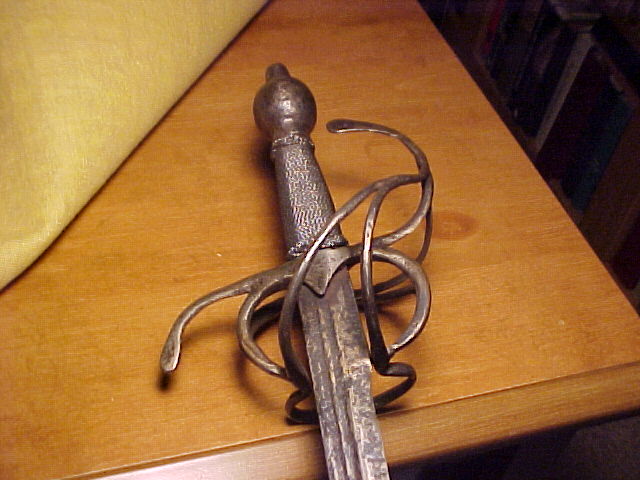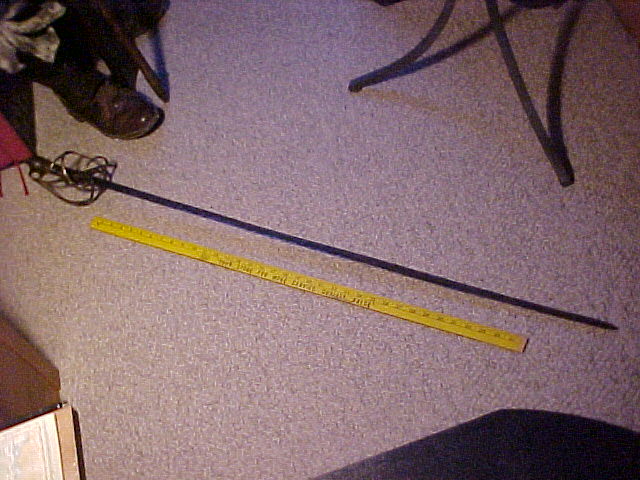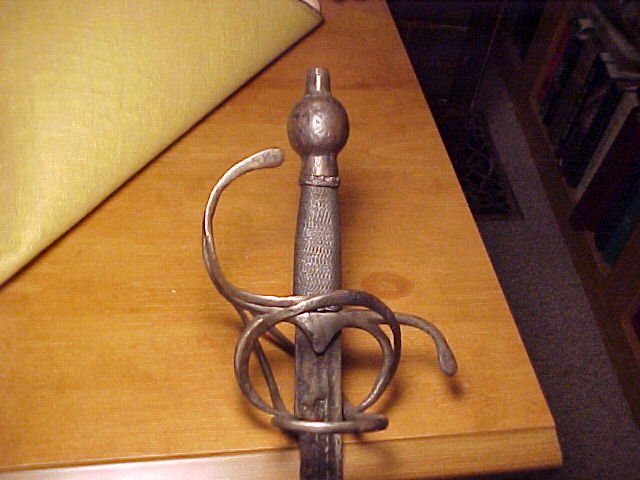| Author |
Message |
|
Scott Woodruff
|
 Posted: Fri 07 Jan, 2011 8:33 am Post subject: Posted: Fri 07 Jan, 2011 8:33 am Post subject: |
 |
|
Simon, I wish with all my heart that I could find a picture of that sword, but as long as it is possession of the Pueblo, that is very unlikely to happen. However, there are some similar examples in the complex-hilted bastard sword thread on this site. The only feature of the sword that was somewhat unusual was the thumb-ring, otherwise it was pretty similar to a lot of German and Spanish complex-hilted longswords.
Randal, I did not mean to suggest that the crossbow suddenly dropped out of use in 1520, just that it began a serious decline around that time. Certainly, by the time of the Pueblo Rebellion, the crossbow was almost non-existent in European warfare, but was still a primary weapon on the Northern Frontier. Plate armor certainly saw fairly wide use in the New World, but not so much in New Mexico. "Far less common" is probably a better choice of words than "almost non-existent". There is at least one suit of full semi-gothic plate from New Mexico. I do think that the idea of plate for horsemen and textile and mail for foot does not apply to the situation in the southwest. Warfare here was almost exclusively mounted, with the majority of mounted warriors wearing cotton and/or mail. I will have to get back to you on the scale armor, but I am reasonably comfortable with my assertion that scale was widespread on the Frontier. I will see what I can find on the Irish mercenaries. I cannot remember now where I read that, and would probably have to dig into primary sources to find documentation. I mentioned it hoping to stimulate some interest and maybe recieve some more detailed info.
Paul, indeed the sword shown is the type usually associated with conquistadors and saw wide use in the New World. However, here in New Mexico, the typical 16th century sword is of bastard/great sword dimensions. These weapons are ideal for mounted use. I myself have little mounted combat experience, but I have no problem using a sword of the dimensions I described 1-handed with a buckler.
Thank you all, I am happy to find others that share my interest in the arms and armor of the conquistadors.
|
|
  |
 |
Paul Hansen

|
 Posted: Fri 07 Jan, 2011 8:41 am Post subject: Posted: Fri 07 Jan, 2011 8:41 am Post subject: |
 |
|
| Sean Flynt wrote: | | Post 1550 German longswords with single-hand primary grips, complex hilts and, often, SE blades, were used by mounted soldiers. A bastard sword or longsword would be useful against infantry. |
Longswords aren't really my thing, so I haven't studied them in depth, but the swords you've shown have a grip construction that is a bit different than the "standard", and which may be much easier to use single-handed.
And I'm not so sure that these swords were as popular in Spain as they were in Germany.
|
|
  |
 |
|
Scott Woodruff
|
 Posted: Fri 07 Jan, 2011 9:01 am Post subject: Posted: Fri 07 Jan, 2011 9:01 am Post subject: |
 |
|
Randal, the paper by Hugh C. Rogers and Donald J. La Rocca on the scales found in Aztec NM mentions "127 shield shaped plates from several collections" plus 198 that have not been examined. They also allude to "scattered finds." When I revisit the Albuquerque museum, I will take some notes on the scale armor I am sure I remember seeing there. I think there are a lot of scale finds that have never been properly documented.
Paul, a long-sword does not need any special grip construction to be used one-handed. YMMV, but I have no problem wielding a longsword one-handed with a buckler. My longsword has a 34 inch blade and a simple no-frills grip and weighs almost 4 pounds. The longsword at Acoma also has a simple grip with a little swell in the middle and a gradual taper, with thin leather thongs wrapped around it. Much heavier weapons can be used one-hande on horseback because recovery time is not such a limiting factor, as you are rapidly moving away from your target as you recover.
|
|
  |
 |
|
Scott Woodruff
|
 Posted: Fri 07 Jan, 2011 9:24 am Post subject: Posted: Fri 07 Jan, 2011 9:24 am Post subject: |
 |
|
|
I just did a quick internet search to see what I could find about Irish mercenaries in the New World. I found numerous references to Coronados use of both Native and European mercenaries, but no specific mention of Irish mercenaries. The earliest Irish mercenary I could find documentation for was Hugh O'Conor, who founded la Presidio Santa Cruz de Terrenate for King Carlos III in 1776. So while it is possible I was confusing the two, I also find it quite reasonable that Irish mercenaries accompanied Corornado. I will keep digging, I just find the idea of Irishmen fighting alongside Native warriors and Spanish soldiers fascinating.
|
|
  |
 |
|
Joel Minturn
|
 Posted: Fri 07 Jan, 2011 12:19 pm Post subject: Posted: Fri 07 Jan, 2011 12:19 pm Post subject: |
 |
|
Scott - The idea of doing a recreation from that time period does sound interesting. Though I would like to recreate one of the native warriors. It would be fun to be wearing a morian and have a lance and tell people that "no I am not doing a Spanish persona this is an American Indian" and watch them try to get there heads around that.
With all the talk about Spanish crossbows. New World Arbalest make a reproduction of a crossbow from 1554 that was found just off Padre Island. http://crossbows.net/4D_padre.php I have two of there crossbows and have been really impressed with there work.
|
|
  |
 |
Randall Moffett

|
 Posted: Fri 07 Jan, 2011 1:31 pm Post subject: Posted: Fri 07 Jan, 2011 1:31 pm Post subject: |
 |
|
Scott,
I have seen the article but it seems like the ones they are looking at are from one find. I did not recall any scattered finds but will take a second look when I have a few minutes together. I find it very interesting if it was becoming a primary type of armour in the new world.
No doubt they adapted to suit their optimal performance in war there and if going with lighter armour and such did this I am sure they did. As well some of this likely happened long after they arrived in the americas and found what mix worked best for them.
RPM
|
|
  |
 |
|
Timothy Burke
Location: Florida Joined: 08 Jan 2011
Posts: 1
|
|
   |
 |
|
Scott Woodruff
|
 Posted: Sun 09 Jan, 2011 9:58 pm Post subject: Posted: Sun 09 Jan, 2011 9:58 pm Post subject: |
 |
|
Joel, I am not sure about the morion, but I agree that it can be realy cool when unbiased research paints a picture contrary to popular conceptions. I really need to do some more research on this subject. I can not go to Sweden and look at swords, but there is plenty to learn about in my own back-yard. If my memory serves me correctly, by the time of the Pueblo Rebellion, armor made from layers of cow or buffaloe hide would have been the only armor in wide use. I have never come across any mention of Native use of helmets in this period, but common sense seems to suggest that they must have been used. Miquelet-lock escopitas were beginning to appear around this time, but the overall rarity of firearms allowed the lance to maintain its position as dominant weapon. By the 1580's, the espada ancha, a version of a hunting sword often made from cut-down oder blades had mostly replaced the longsword. I am not sure if the more primitive wicker shields and wooden slat armor survived this long, I think both were rapidly replaced by tougher hide versions soon after contact. There is a really good book with detailed info on Pueblo weapons at the local library, so I wil check it out on Tuesday and see what I can come up with for you. I would be very excited to see you create a Puebo kit and would help you any way I can.
Randal, the article is rather vague, and does not provide much information, but does seem to suggest multiple finds. I doubt that the relatively thin scales provided much protection, and were probably mostly just a way to dress up the rather drab textile (early) and hide (later) armor. I will have to re-read the article and see if they have assigned a date to the scales. Now that I think about it, the scales I think I saw in the Alb. museum may well have been brigadine plates. I will definitely have to go check soon.
|
|
  |
 |
Michail F

Location: MN, USA Joined: 04 Feb 2005
Posts: 7
|
 Posted: Tue 11 Jan, 2011 8:04 am Post subject: European rapier, early?, wide fullered blade, r Posted: Tue 11 Jan, 2011 8:04 am Post subject: European rapier, early?, wide fullered blade, r |
 |
|
Speaking of rapiers, I have what I believe to be an original rapier, maybe mid-late 1600s?, with somewhat developed hilt but using a very wide, flat, very long blade as shown. It is not a finely made piece, as forge welding is not of the higher officer/wealthy soldier could afford, yet the work done is quite competently. This rapier I'd guess could have spent some time in the earth, or near salt water, as it is very corroded in places, especially on the blade. All metal seems to me to be original and old, though I know it is possible to reproduce almost anything, but wire wrap looks good, is well done, nothing looks replaced, blade, though the fullers are crude, is tempered well. The most interesting thing to me as a non-expert is that the blade, though flat is so incredibly long-full "classic period" rapier length at 45 inches.
This item was bought through an Italian auction house years ago, and I'd welcome any comments on it. At the same auction I got an equally interesting swept hilt military rapier with complex hilt, nicely wrought, with a much heavier though thinner blade; surely a war sword in every way. Mike
 Attachment: 58.77 KB Attachment: 58.77 KB

 Attachment: 73.59 KB Attachment: 73.59 KB

 Attachment: 55.89 KB Attachment: 55.89 KB

|
|
  |
 |
|
|
You cannot post new topics in this forum
You cannot reply to topics in this forum
You cannot edit your posts in this forum
You cannot delete your posts in this forum
You cannot vote in polls in this forum
You cannot attach files in this forum
You can download files in this forum
|
All contents © Copyright 2003-2024 myArmoury.com — All rights reserved
Discussion forums powered by phpBB © The phpBB Group
Switch to the Basic Low-bandwidth Version of the forum
|

